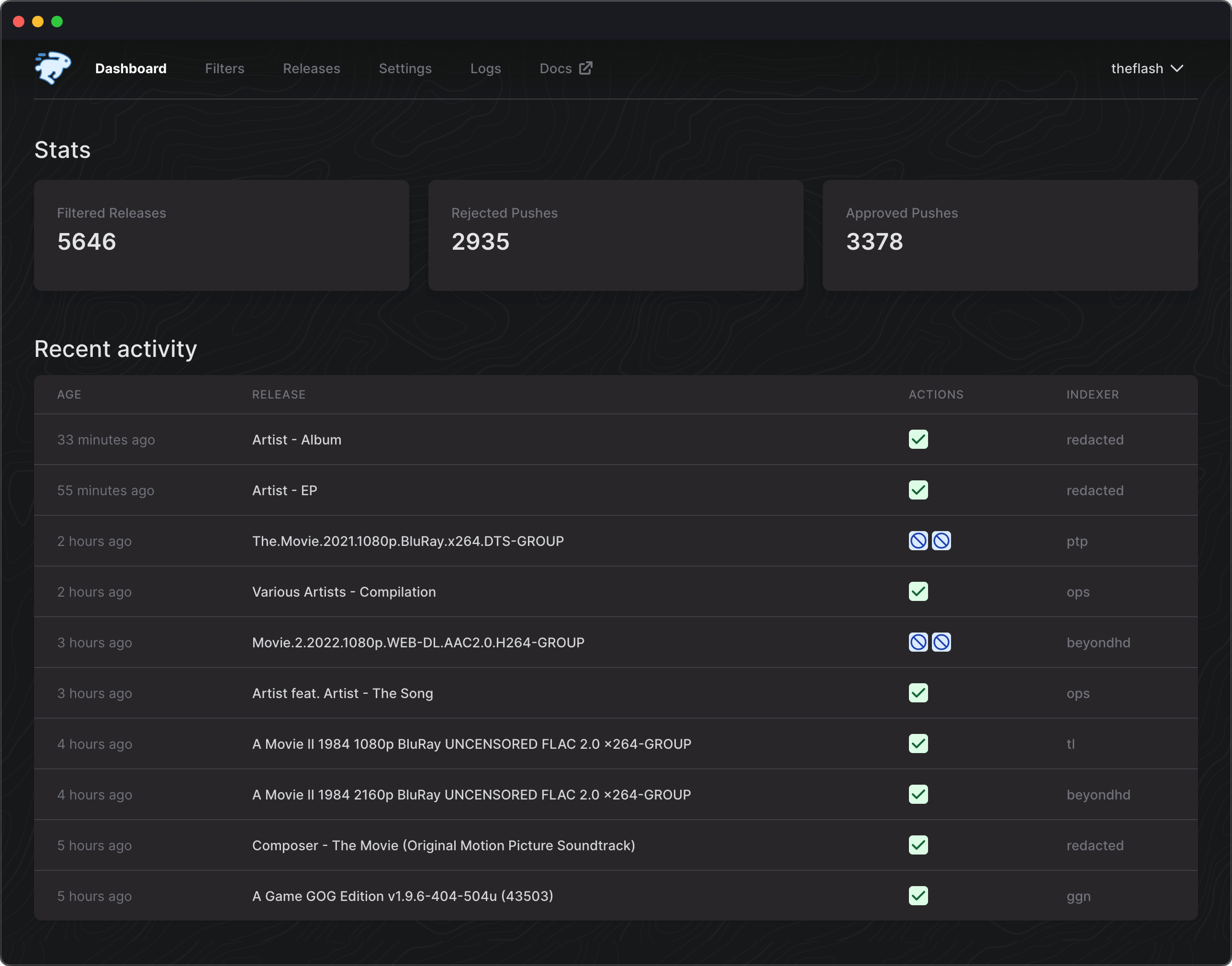autobrr is the modern download automation tool for torrents. With inspiration and ideas from tools like trackarr, autodl-irssi and flexget we built one tool that can do it all, and then some.
Installation guide and documentation can be found at https://autobrr.com
- Support for 40+ trackers with IRC announces
- Torznab/RSS support via Prowlarr to easily get access to hundreds of trackers
- Powerful but simple filtering with RegEx support (like in autodl-irssi)
- Easy to use and mobile friendly web UI (with dark mode!) to manage everything
- Built on Go and React making autobrr lightweight and perfect for supporting multiple platforms (Linux, Windows, macOS) on different architectures (e.g. x86, ARM)
- Great container support (Docker, k8s/Kubernetes)
- Database engine supporting both PostgreSQL and SQLite
- Notifications (Discord, Telegram, Notifiarr)
- One autobrr instance can communicate with multiple clients (both torrent and *arr) on remote servers
- Base path / Subfolder (and subdomain) support for convenient reverse-proxy support
Available download clients and actions
- qBittorrent (with built in re-announce, categories, rules, max active downloads, etc)
- Deluge v1+ and v2+
- Transmission
- Sonarr, Radarr, Lidarr and Whisparr (pushes releases directly to them and gets in the early swarm, instead of getting them via RSS when it's already over)
- Watch folder
- Exec custom scripts
- Webhook
Full installation guide and documentation can be found at https://autobrr.com
Remember to head over to our Configuration Guide to learn how to set up your indexers, IRC, and download clients after you're done installing.
Swizzin users can simply run:
sudo box install autobrr
Saltbox users can simply run:
sb install sandbox-autobrr
For more info check the docs
QuickBox users can simply run:
qb install autobrr -u ${username}
For more info check the docs
We have support for a couple of providers out of the box and if yours are missing then please write on Discord so we add support.
The scripts requires some input but does most of the work.
curl https://gobrr.sh/install_sbio | bash
curl https://gobrr.sh/install_sbio | bash
curl https://gobrr.sh/install_ultra | bash
curl https://gobrr.sh/install_whatbox | bash
For other providers the Seedboxio installer should work. If not, open an issue or contact us on Discord
curl https://gobrr.sh/install_sbio | bash
docker-compose for autobrr. Modify accordingly if running with unRAID or setting up with Portainer.
- Logging is optional
- Host port mapping might need to be changed to not collide with other apps
- Change
BASE_DOCKER_DATA_PATHto match your setup. Can be simply./data - Set custom network if needed
Create docker-compose.yml and add the following. If you have a existing setup change to fit that.
version: "3.7"
services:
autobrr:
container_name: autobrr
image: ghcr.io/autobrr/autobrr:latest
restart: unless-stopped
environment:
- PUID=${PUID}
- PGID=${GUID}
- TZ=${TZ}
volumes:
- ${BASE_DOCKER_DATA_PATH}/autobrr/config:/config
ports:
- 7474:7474Then start with
docker compose up -d
Check the windows setup guide here
Download the latest release, or download the source code and build it yourself using make build.
wget $(curl -s https://api.github.com/repos/autobrr/autobrr/releases/latest | grep download | grep linux_x86_64 | cut -d\" -f4)Run with root or sudo. If you do not have root, or are on a shared system, place the binaries somewhere in your home directory like ~/.bin.
tar -C /usr/local/bin -xzf autobrr*.tar.gzThis will extract both autobrr and autobrrctl to /usr/local/bin.
Note: If the command fails, prefix it with sudo and re-run again.
On Linux-based systems, it is recommended to run autobrr as sort of a service with auto-restarting capabilities, in order to account for potential downtime. The most common way is to do it via systemd.
You will need to create a service file in /etc/systemd/system/ called autobrr.service.
touch /etc/systemd/system/autobrr@.serviceThen place the following content inside the file (e.g. via nano/vim/ed):
[Unit]
Description=autobrr service for %i
After=syslog.target network-online.target
[Service]
Type=simple
User=%i
Group=%i
ExecStart=/usr/bin/autobrr --config=/home/%i/.config/autobrr/
[Install]
WantedBy=multi-user.target
Start the service. Enable will make it startup on reboot.
systemctl enable -q --now --user autobrrIt's highly advised to put it behind a reverse-proxy like nginx or traefik etc.
Come join us on Discord!




